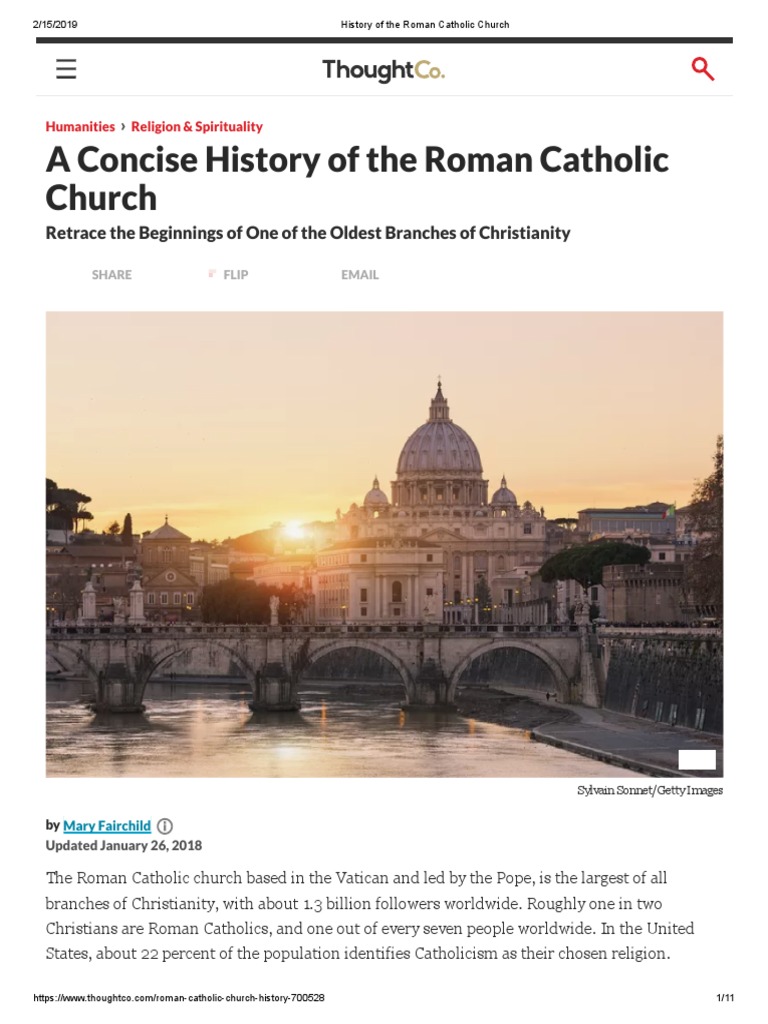The origins of the Roman Catholic Church are steeped in rich history and profound theological developments that span nearly two millennia. At its genesis, the Church emerged from a milieu of diverse religious practices and political turmoil during the late Roman Empire. This confluence of factors would shape a faith that would not only endure but flourish, evolving into the largest Christian denomination in the world. To comprehend how the Roman Catholic Church began, one must delve into its foundational elements, tracing the footsteps from its nascent stages to the establishment of a formal ecclesiastical structure.
At the crux of this narrative is Jesus Christ, whose ministry in the first century laid the initial groundwork. His teachings, grounded in Jewish tradition, emphasized love, compassion, and repentance. The focal point of Jesus’ ministry was the proclamation of the Kingdom of God. As he gathered disciples, his followers began to coalesce around his teachings, a phenomenon which would burgeon into what we recognize today as Christianity. After the crucifixion, resurrection, and ascension of Jesus, his apostles became fervent evangelists. Their journeys across the Roman Empire catalyzed the spread of Christian beliefs, despite facing persecution and adversity.
The apostolic age, marking the first several decades after Christ’s resurrection, witnessed the establishment of Christian communities in major urban centers such as Jerusalem, Antioch, and Rome. These early Christians would partake in communal worship, celebrate the Eucharist, and share teachings that eventually coalesced into the New Testament canon. Apostolic figures like Peter and Paul became instrumental in these formative years. Peter, often regarded as the first pope, is attributed with the foundational leadership of the Church, particularly in Rome, where he is believed to have been martyred, solidifying Rome’s significance in the Christian tradition.
As Christianity gained traction, its development was markedly influenced by the socio-political landscape of the Roman Empire. The Edict of Milan in 313 AD, issued by Emperor Constantine, marked a pivotal moment in Christian history. This decree granted religious toleration for Christianity, transforming it from a persecuted sect into a state-sanctioned religion. Constantine’s conversion not only provided the Church with legitimacy but also catalyzed the construction of significant ecclesiastical structures, including the revered Basilica of St. Peter in Rome.
In the subsequent centuries, the Roman Catholic Church began to delineate its doctrine and establish ecclesiastical hierarchy. The early Church grappled with various theological disputes, leading to ecumenical councils—gatherings of church leaders aimed at addressing heresies and formulating orthodox beliefs. The First Council of Nicaea in 325 AD, for instance, produced the Nicene Creed, a foundational statement of Christian faith that affirmed the divinity of Christ and the doctrine of the Trinity. Such councils were essential in unifying beliefs across the expanding Church.
During the medieval period, the Roman Catholic Church emerged as a dominant force in Europe, intertwining itself with the fabric of society. The Church’s influence permeated every facet of life, from governance to education. The establishment of monastic orders, such as the Benedictines and Franciscans, contributed to the preservation of knowledge and cultural development during the so-called Dark Ages. Monasteries served as centers of learning, where the copying of texts ensured the survival of classical and Christian literature.
Through the Middle Ages, the papacy established itself as a formidable institution. The pope not only exerted spiritual authority but also wielded political power, often mediating conflicts between monarchs and kingdoms. This duality of influence fostered an environment rife with both collaboration and contention, culminating in epochs of tension, like the Investiture Controversy, which revolved around the appointment of bishops and the relationship between church and state.
By the 11th century, the Great Schism further fractured the Christian community, leading to a lasting division between the Roman Catholic Church and the Eastern Orthodox Church. This schism centered on doctrinal disagreements and issues of papal authority. While the Catholic Church remained firmly rooted in its Latin traditions, the Eastern Orthodox Church maintained its practices and theological principles derived from the Byzantine heritage.
As the Renaissance unfolded in the 15th century, marked by a resurgence of interest in classical thought and humanism, the Catholic Church faced increasing scrutiny. Reformers like Martin Luther advocated for profound theological changes, calling for a return to Biblical foundations and criticizing various church practices. The Protestant Reformation led to a fracturing of Western Christianity and prompted the Catholic Church to initiate its own Counter-Reformation, during which it sought to reaffirm its doctrines and curb corruption. The Council of Trent (1545-1563) was a significant response, leading to distinct clarifications of Catholic theology and ecclesiastical reforms.
The Roman Catholic Church’s history is characterized by a remarkable ability to adapt and evolve. From its humble origins to its contemporary global presence, the Church has continually grappled with theological, cultural, and sociopolitical challenges. Each epoch has contributed to its identity, solidifying its role not just as a religious institution but as a cultural and historical force. Today, the Roman Catholic Church continues to engage with modern issues while remaining firmly rooted in its rich heritage, from its apostolic beginnings to its current global mission.
In understanding how the Roman Catholic Church began, one appreciates not only its historical narrative but also the ongoing influence it has on millions of lives worldwide. Its origins encapsulate a journey filled with divine inspiration, human frailty, and persistent faith, reflecting the enduring nature of the Christian message through the ages.



